![]()
![]()
![]()
Use LEFT and RIGHT arrow keys to navigate between flashcards;
Use UP and DOWN arrow keys to flip the card;
H to show hint;
A reads text to speech;
24 Cards in this Set
- Front
- Back
|
Melanocytes
|
effects pigmentation, found in or at the basal (deepest) layer of the epidermis and have long dendritic extensions that extend to the keratinocytes in the more superficial layers of the epidermis, the main function is to protect the skin from harmful ultraviolet rays by producing melanin
|
|
|
Melanin
|
black or brown substance that imparts color to the skin
|
|
|
Physiologic pigmentation
|
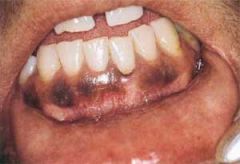
usually found in the gingiva, but can occur throughout the mouth
|
|
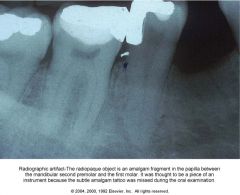
Amalgam tattoo
|
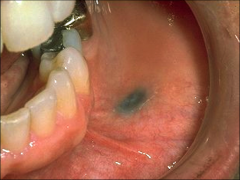
also called focal argyrosis, occur because of amalgam particles becoming imbedded within the tissue
|
|
|
Argyria
|
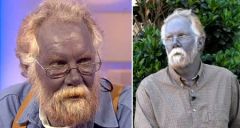
the slate-gray or bluish discoloration of the skin caused by the accumulation of silver salts in the tissue
|
|
|
Diascopy
|
may be used to differentiate heavy metals from common gingivitis around the margins of crowns
|
|
|
Plumbism
|
lead poisoning, has been a significant problem in children in past decades and is usually due to environmental causes such chipping paint, putty, plaster, pesticides, and lead-lined pipes
|
|
|
Minocycline tissue staining
|
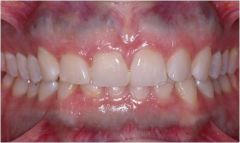
black bone staining, caused by ingestion of minocycline, a semisynthetic tetracycline that was introduced in the 1960s, dark staining of hard and soft tissues is associated with the medication when used long term
|
|
|
Quid
|
refers to a mixture of substances placed in the mouth and remaining in contact with the mucosa, usually containing one or both of the two basic ingredients, tobacco or areca nut, in raw or any manufactured or processed form
|
|
|
Oral submucosa fibrosis (OSF)
|
a premalignant condition seen predominantly in Southeast Asia with the use of betel nut, areca nut, and tobacco products
|
|
|
Nevus
|
commonly referred to as a mole and infrewuently seen orally, also known as pigmented nevus, melanocytic nevus, and nevomelanocytic nevus, benign
|
|
|
In order of their frequencey list the different forms of nevous
|
the intramucosal nevus, the blue nevus, the compound nevous and the junctional nevus
|
|
|
Third classification of nevus
|
intradermal nevus and intramucosal nevus
|
|
|
Labial melanotic macules
|
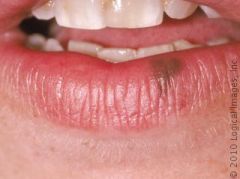
occurs on the lips, focal pigmented lesion
|
|
|
Ephelis
|
occur on the lips as a freckle, tend to be less than 0.5cm and are associated with sun exposure
|
|
|
Solar lentigos
|
usually seen in older individuals, are much larger then ephelides and tend to persist indefinitely even with sun exposure, more pigmented then ephelides
|
|
|
Lentigo maligna
|
when changes occur with oral melanotic macules, such as increased growth or shape, there could be a suspicion of a lesion that is characterized by early atypical melanocytes
|
|
|
Laugier-Hunziker syndrome
|
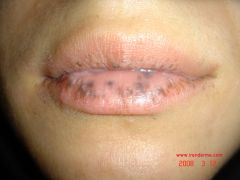
an acquired, benign, macular hyperpigmentation of the lips and oral mucosa, as well as the nails
|
|
|
Focal melanosis
|
also called oral melanotic macule, a focal pigmented lesion that occurs on the lip or the intraoral tissues, two types: oral melanotic macule and labial melanotic macule
|
|
|
Amelanotic melanoma
|

melanomas that are light in color and blend into the surrounding tissue
|
|
|
Biologic therapy
|
stimulates or restores the ability of the immune system to fight cancer, infections and other disease states
|
|
|
Smoker's melanosis
|
also called tobacco associated melanosis, caused by the use of tobacco products that stimulate the production of melanocytes within the tissue.
|
|
|
Melanoma
|
the third most occurring skin cancer, caused by malignant cells that are capable of producing melanin and may originate from a pigmented nevus, have the ability to spread to other organs within the body in later stages
|
|
|
Basal keratinocytes
|
an increase of melanin pigmentation in physiologic pigmentation
|

